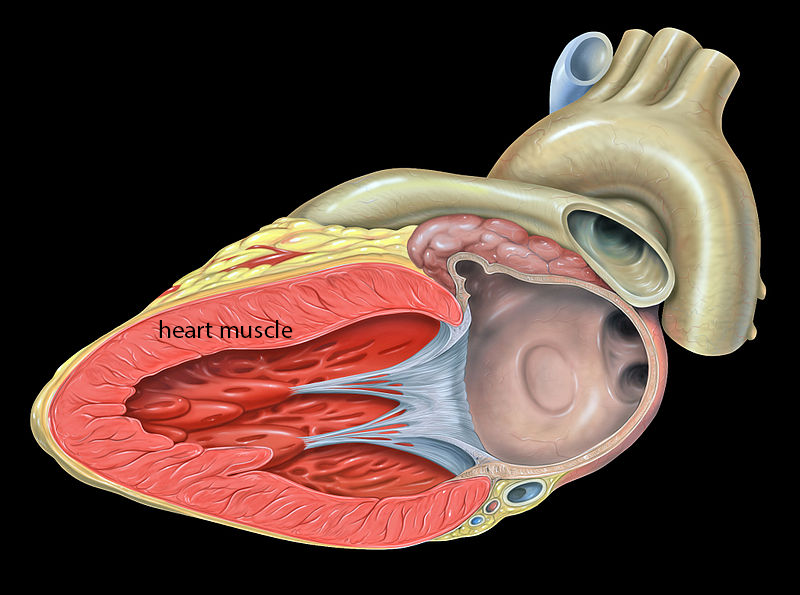Cardiomyopathies are very common causes of exercise-related cardiac arrest in youth and young adults, but can occur to anyone at any age. An unfortunate example is the case of a 45-year-old seasoned runner who collapsed during a marathon last November in Tennessee. The autopsy revealed an unsuspected cardiomyopathy.
What is a cardiomyopathy?
Generally speaking, a cardiomyopathy is a condition that primarily affects the heart muscle itself, in contrast to conditions that primarily affect the coronary arteries of the heart, the heart valves, the heart rhythm, or other cardiac components.
Note that coronary artery disease, valvular heart disease, and disturbances of the heart rhythm, can also eventually lead to damage of the heart muscle. In these cases, the cardiomyopathy is said to be secondary to the initial problem. Conversely, a primary cardiomyopathy may secondarily affect the heart rhythm, the heart valves, or other aspects of the heart.
Before going further, let’s look at a diagram of the heart:

Image attribution: Patrick J. Lynch, medical illustrator; C. Carl Jaffe, MD, cardiologist http://creativecommons.org/licenses/by/2.5/
You can see that the main pumping chamber of the heart, the left ventricle (seen here in cross-section), has a fairly thick muscular wall. When this muscle contracts with each heartbeat, the blood that is inside the cavity gets pumped out of the heart.
The right ventricle (the other pumping chamber, not seen on this diagram because it is behind the left ventricle) also has a muscular wall, but the wall is normally not as thick as the left ventricle wall.
Cardiomyopathies, therefore, are conditions that affect the heart muscle proper. Most commonly, it is the the left ventricular wall that is affected, but the right ventricle can suffer from cardiomyopathy as well.
Are there different types of cardiomyopathies?
There are different types of cardiomyopathies, and different ways of classifying them.
One way to classify cardiomyopathies is to simply describe the effect of the condition on the heart muscle:
- hypertrophic: the protein content inside heart muscle cells is increased and the walls of the heart muscle become much thicker (hypertrophic) as a result.
- dilated: the structure of the heart muscle fibers is disrupted and the ventricular wall becomes thin and weak. The ventricle dilates (the cavity enlarges) as a result.
- restrictive: the walls of the heart muscle are infiltrated by other protein or fibrous material that make the ventricle stiff.
Another way to classify cardiomyopathies is by cause:
- genetic: some involve the left ventricle (hypertrophic cardiomyopathy proper), other the right ventricle (for example, ARVC = arrhythmogenic right ventricular cardiomyopathy)
- viral: a virus has infected the heart and the heart muscle becomes weak, presenting usually as a dilated cardiomyopathy
- toxic or nutritional: certain substances can be toxic to the heart, notably alcohol and cocaine. Nutritional deficiencies can also lead to a cardiomyopathy.
- hypertensive: uncontrolled high blood pressure can lead to hypertrophy of the heart muscle or, in later stages, dilation.
- valvular: when the heart valves do not function properly, the ventricle may either hypertrophy or become dilated, depending on the specific valvular problem.
- ischemic: when blockages in the coronary arteries reduce blood flow going to the heart muscle (causing “ischemia”), the heart becomes weak or, if a “heart attack” has occurred, becomes irreversibly damaged (necrosis).
- infiltrative: these are rare forms of heart muscle diseases due to to an accumulation of material such as amyloid protein, iron, or inflammatory cells. These infiltration may lead to a restrictive or dilated form of cardiomyopathy.
What is the significance of having a cardiomyopathy?
If the heart muscle is impaired, it will usually lead to poor function of the heart and cardiac symptoms. The most ominous consequence of cardiomyopathy is sudden cardiac arrest.
Fortunately, if cardiomyopathy is detected promptly, the risk of sudden cardiac arrest can be minimized or eliminated. Depending on the type of cardiomyopathy, treatment can improve symptoms or even reverse the malfunction of the heart.
In subsequent posts, we will describe the individual cardiomyopathies in more detail. I hope you have found this post useful.
Dr. Accad
